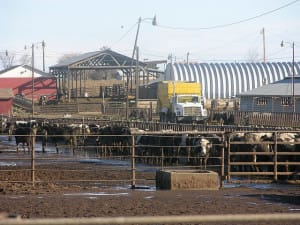U.S. News & World Report
by Robert Preidt
 |
Overuse of antibiotics in farm animals poses a real health risk to children, the American Academy of Pediatrics warns in a new report.
This common practice is already contributing to bacterial resistance to medicines and affecting doctors’ ability to treat life-threatening infections in kids, according to the paper published online Nov. 16 in the journal Pediatrics.
One expert in the field supported the academy’s stance.
“The connection between production uses of antibiotics in the agricultural sector to antibiotic resistance is alarming,” said Victoria Richards, an associate professor of medical sciences at the Quinnipiac University School of Medicine in Hamden, Conn.
She believes the danger is “not only for infants and children but other vulnerable populations, such as the pregnant and the older individuals.”
As the academy explained in its warning, antibiotics are often added to the feed of healthy livestock to boost growth, increase feed efficiency or prevent disease. However, the practice can also make antibiotics ineffective when they are needed to treat infections in people.
Some examples of emerging antibiotic germs include methicillin-resistant staphylococcus aureus (MRSA), C.difficile, and highly resistant strains of the tuberculosis bacterium.
Each year, more than 2 million Americans develop antibiotic-resistant infections and more than 23,000 die from these infections, the academy said. And in 2013, the highest incidence of such infections was among children younger than 5, federal government statistics show.
“Children can be exposed to multiple-drug resistant bacteria, which are extremely difficult to treat if they cause an infection, through contact with animals given antibiotics and through consuming the meat of those animals,” report author Dr. Jerome Paulson, immediate past chair of the academy’s executive committee of the Council on Environmental Health, said in an academy news release.
“Like humans, farm animals should receive appropriate antibiotics for bacterial infections,” he said. “However, the indiscriminate use of antibiotics without a prescription or the input of a veterinarian puts the health of children at risk.”
Dr. Ken Spaeth is chief of occupational and environmental medicine at North Shore-LIJ Health System in Great Neck, N.Y. He said that, given the huge quantities of antibiotics given to livestock each year, “it should be no surprise that animals receiving these antibiotics eventually produce and spread antibiotic-resistant bacteria.”
“Some of these drug-resistant bacteria have been found in the intestinal flora [microbial communities] of humans, while other such bacteria end up reaching consumers via contaminated meat and chicken,” Spaeth explained.
“What’s more, the resistant bacteria end up spreading into the ambient environment through water, soil and air that comes in contact with the bacteria,” he added, “thereby creating reservoirs of resistant strains which allow for further expansion of resistance.”
Spaeth noted that the U.S. Centers for Disease Control and Prevention, as well as the World Health Organization, have both called for a curbing of antibiotic use in animals. But the authors of the new report expressed concern over resistance from the agriculture and farming industry to such measures.
More information
The U.S. Centers for Disease Control and Prevention has more about antibiotic resistance.

